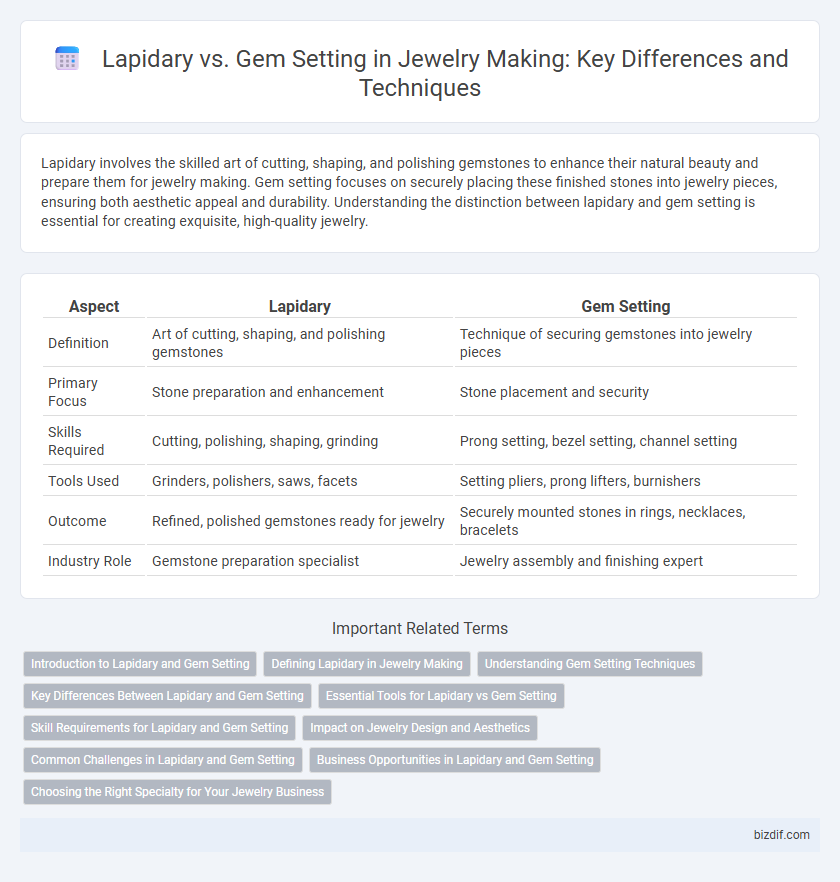Lapidary involves the skilled art of cutting, shaping, and polishing gemstones to enhance their natural beauty and prepare them for jewelry making. Gem setting focuses on securely placing these finished stones into jewelry pieces, ensuring both aesthetic appeal and durability. Understanding the distinction between lapidary and gem setting is essential for creating exquisite, high-quality jewelry.
Table of Comparison
| Aspect | Lapidary | Gem Setting |
|---|---|---|
| Definition | Art of cutting, shaping, and polishing gemstones | Technique of securing gemstones into jewelry pieces |
| Primary Focus | Stone preparation and enhancement | Stone placement and security |
| Skills Required | Cutting, polishing, shaping, grinding | Prong setting, bezel setting, channel setting |
| Tools Used | Grinders, polishers, saws, facets | Setting pliers, prong lifters, burnishers |
| Outcome | Refined, polished gemstones ready for jewelry | Securely mounted stones in rings, necklaces, bracelets |
| Industry Role | Gemstone preparation specialist | Jewelry assembly and finishing expert |
Introduction to Lapidary and Gem Setting
Lapidary involves the art of cutting, shaping, and polishing gemstones to enhance their natural beauty and prepare them for jewelry use. Gem setting focuses on securely placing these polished stones into jewelry pieces, using techniques such as prong, bezel, or channel setting to maximize visual appeal and durability. Both crafts require precision and skill, with lapidary emphasizing stone preparation and gem setting highlighting the integration of stones into finished designs.
Defining Lapidary in Jewelry Making
Lapidary in jewelry making refers to the art and technique of cutting, shaping, and polishing gemstones to enhance their natural beauty and prepare them for setting. This process involves precision tools and skilled craftsmanship to transform rough stones into smooth, faceted gems that exhibit maximum brilliance and clarity. Mastery of lapidary skills directly impacts the quality and aesthetic appeal of finished jewelry pieces.
Understanding Gem Setting Techniques
Gem setting techniques involve securely placing gemstones into jewelry by creating precise seats in metal structures, ensuring both protection and aesthetic appeal. Lapidary skills complement gem setting by shaping and polishing raw stones to fit these settings perfectly, enhancing the overall finish. Mastery of various settings such as prong, bezel, and channel ensures durability and highlights the gem's brilliance in the final piece.
Key Differences Between Lapidary and Gem Setting
Lapidary involves the cutting, shaping, and polishing of raw gemstones to bring out their natural beauty and enhance their optical properties. Gem setting focuses on securely placing and mounting these polished stones into jewelry designs, ensuring both aesthetic appeal and durability. The primary difference lies in lapidary's emphasis on stone preparation, while gem setting prioritizes the integration of the gem into finished pieces.
Essential Tools for Lapidary vs Gem Setting
Essential tools for lapidary include grinding wheels, polishing pads, and faceting machines designed to cut and shape raw gemstones precisely. Gem setting requires specialized tools such as prong pushers, bezel rollers, and setting burrs for securely placing and fixing stones into jewelry settings. Mastery of both toolsets enables the creation of finely crafted gemstones and professionally finished jewelry pieces.
Skill Requirements for Lapidary and Gem Setting
Lapidary requires mastery in cutting, shaping, and polishing raw stones to enhance their natural beauty, demanding precision and an understanding of stone properties. Gem setting involves securing cut gems into jewelry, requiring meticulous attention to detail, steady hands, and expertise in various setting techniques like prong, bezel, and pave. Both skills demand specialized training, but lapidaries focus more on transformation of raw materials, while gem setters excel in integrating stones seamlessly into designs.
Impact on Jewelry Design and Aesthetics
Lapidary techniques shape and polish gemstones to enhance their natural brilliance, directly influencing the texture and visual appeal of jewelry pieces. Gem setting secures these stones into designs, affecting the overall structure, symmetry, and light reflection in the final product. Together, lapidary and gem setting are crucial for achieving both functional durability and striking aesthetic balance in jewelry design.
Common Challenges in Lapidary and Gem Setting
Common challenges in lapidary involve precise cutting and polishing to enhance a gem's natural beauty while avoiding fractures or inclusions that reduce value. Gem setting requires meticulous attention to secure stones without damaging their delicate surfaces, often complicated by varying stone hardness and shape. Both crafts demand advanced skills and specialized tools to achieve flawless results, balancing aesthetics with structural integrity.
Business Opportunities in Lapidary and Gem Setting
Lapidary offers lucrative business opportunities through custom stone cutting, creating unique cabochons and faceted gems for bespoke jewelry pieces, attracting high-end clientele seeking personalized designs. Gem setting provides steady demand in the jewelry industry by enhancing the value of finished products through skilled mounting techniques that ensure durability and aesthetic appeal. Both fields benefit from growing consumer interest in artisan craftsmanship and sustainable sourcing, driving revenue growth in niche markets within the jewelry sector.
Choosing the Right Specialty for Your Jewelry Business
Lapidary focuses on shaping and polishing gemstones to enhance their natural beauty, requiring skills in cutting techniques and precision tools. Gem setting involves securely placing stones into jewelry designs, emphasizing expertise in metalwork and different setting styles like prong, bezel, and pave. Selecting the right specialty depends on your business goals, whether prioritizing stone craftsmanship or intricate jewelry assembly to meet market demands.
Lapidary vs Gem Setting Infographic

 bizdif.com
bizdif.com